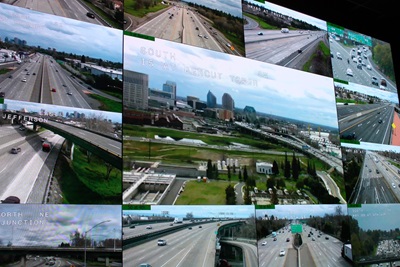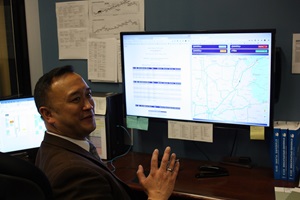The massive bank of monitors in the center’s main control room displays live streams from throughout the district. The images, all from high-definition cameras, can be zoomed in on, and the cameras can be redirected. 
Every Caltrans regional district has its own traffic management center. None of those TMCs, however, is quite like District 3’s.
Its Rancho Cordova building is bedecked with high-tech.
“We want everyone to have what we have, because then everything will get better,” title?Manager Brian Alconcel said near the end of a two-hour tour of the facility last month.
What District 3’s TMC has is a recently upgraded video wall that gives Caltrans operators and dispatchers – and their California Highway Patrol “room” mates – fast access to vast troves of information. When a traffic incident occurs, the center can pounce. At the touch of a button, dispatchers, operators and managers can fill the wall with live video images from and near that incident.
With those or any other images coming from the district’s 125 high-definition cameras, TMC personnel can pan, tilt and zoom with barely the lift of a finger.
Caltrans cameras’ live video feeds generally are accessible via QuickMap, but District 3’s TMC has the unique ability to “toggle off” public access to the images when appropriate. Examples include protecting the privacy of people when cameras zoom in on accidents, or ensuring that CHP officers, Caltrans maintenance crews and other emergency response teams can address roadway issues as efficiently as possible.
“That’s helpful to us,” Alconcel said about the toggling feature, “and I think it will be helpful to other districts because you really need that to manage that incident.”
From the scene, an app lets Caltrans maintenance crew leaders use their cellphones to live-stream video images that give TMC folks a better idea of what steps they should take. Drone shots can be incorporated, too. District 3 electrical engineers use a TMC workshop to manufacture different types of cords and antenna equipment that make such communications possible despite the high-altitude remoteness of some traffic incidents along Interstate 80 and U.S. Route 50.

Brian Alconcel, manager of District 3’s Traffic Management Center, in his office last month talks about the site’s technological advances.
District 3’s TMC innovations extend beyond the main operations area. The site also has a sophisticated conference room that can be used for training purposes, too. “It’s actually supporting the other district officers,” said Office of System Operations Chief Joe Rouse, who accompanied Alconcel and CT News on the tour. “It’s basically a very large hub, not just localized to TMC operations.”
The center’s 34,200-square-foot building opened in 1999.
“It was designed to withstand higher seismic loads. It’s outside of flood plains, and it’s built to operate 24/7,” said Alconcel, adding that locker rooms, a full kitchen and – across the street – a Costco warehouse come in handy during crises. The building “has security everywhere, everything’s access-badged. We have an onsite 750-kilowatt generator, onsite diesel fuel, too.”
Even the landscaping has been updated. By 2004, fast-growing trees’ roots has pushed up sidewalks, and asphalt patching tried to tame the bumps and cracks. District 3 executives ordered an outdoor re-do that gives the site an impressive appearance. With drought concerns having receded, the building is routinely washed now, too.
“We’ve got people from Singapore, from Africa, all these people coming in here,” Alconcel said. “We don’t want them tripping and hurting themselves, and also we don’t want it to be an eyesore.”
Transportation officials from near and far are visiting District 3’s TMC to gather ideas they can take home to improve their own operations.
“Brian and his team have not been shy to share what they’ve done and talk about how it’s been done,” Rouse said. “The key is just getting the resources to the districts to be able to do that. And we’re slowly but surely heading that way. This is my vision, as the overall statewide program manager. We want to get everybody using the same types of systems. …
“The initial vision for the TMCs was that they would be able to cover for each other,” Rouse continued. “It’s not evolved that way. I want to change that. That is a personal goal for me is to get everybody using the same type of system. …
“We’re all working together to help achieve this common vision for the TMCs so that they’re able to do the job for the people that they were originally intended to do.”

